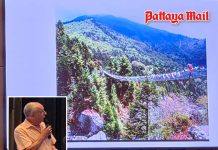A quest to climb the highest point on each of the seven continents was the goal of David Cole, the speaker at the Pattaya City Expats Club meeting on Sunday, July 28. To climb the seven summits is an epic and challenging mountaineering adventure; it demands strong determination, perseverance and endurance – from the cold and unforgiving environments of Everest and Denali, to the remote ice wilderness of Antarctica, the plains of the African subcontinent, and to the barren winds of Aconcagua in South America. David accomplished this goal, being the 8th Australian to do so, on the 19th of December 2011; a task that took him 12 years to complete.
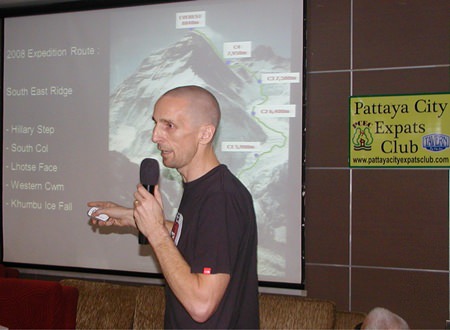 David Cole, PCEC’s speaker for the 28th of July, is one of few Australians to have climbed all the highest peaks on seven continents. He shared with PCEC members the preparations and climb of Mt Everest, which he summited on 21st of May, 2008.
David Cole, PCEC’s speaker for the 28th of July, is one of few Australians to have climbed all the highest peaks on seven continents. He shared with PCEC members the preparations and climb of Mt Everest, which he summited on 21st of May, 2008.
David said that he would talk about his climbing one of these summits; the world’s highest. Mount Everest in the Himalayas stands at height of 8,848 meters. David gave a brief overview of attempts to reach the summit from the first attempt in 1921 until it was first accomplished by New Zealander Edmund Hillary and Nepalese Tenzing Norgay on May 19, 1953. Further, he mentioned that since then, over 3,500 people have reached the summit and 249 died in the effort.
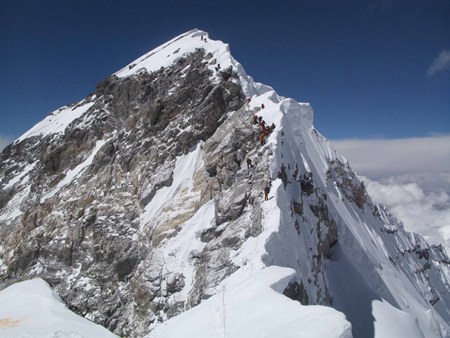 The peak of Everest, including the traffic jam on the infamous ‘Hilary Step’, as seen from the South Peak.
The peak of Everest, including the traffic jam on the infamous ‘Hilary Step’, as seen from the South Peak.
David said he first saw Mount Everest in 1992 and it became his dream to stand on its summit. He displayed many pictures as he described its distinctive towering shape and commented on how it towers over everything. He explained the two approaches, one from the South and the other from the North. When he did his climb in May 2008, he and his 6 companions had to choose the Southern approach as the Chinese government had closed the Northern approach because the Olympic Torch was being carried to the Summit on that side.
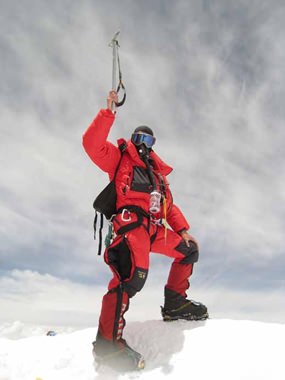 Victory! Many questions followed David’s inspiring presentation.
Victory! Many questions followed David’s inspiring presentation.
He then described the Southeast approach showing the trail from base camp to the summit, which went through the Khumbu Ice Fall (a very dangerous stretch from the base camp to camp 2), Western Cwm (pronounced coom), Lhotse Face, South Col, and finally the Hillary Step to the summit. He explained how each year, a group of locals go up the Mountain scouting the best trail and fixing ropes along it which are used by the climbers (David said that ropes from previous years remain, so when selecting the one to use, you try to find the newest looking one and hope you made the right choice).
David then described their activities in base camp, where they stay for many days acclimatizing to the higher altitude. He explained the necessity of climbing up from base camp to camp 2 and then coming back down to base camp, then repeating the process. Eventually, you stay at camp 2 and climb to camp 3 and return, then again repeat the process. This, he pointed out is done so that you get used to the higher altitude before moving further up the mountain. He said the objective was to “climb high, sleep low.” Further, when not actually climbing, they spent most of their time eating, sleeping, and playing cards.
He also mentioned that most of the time you do not feel very good, much like experiencing a hangover; likewise not having much appetite. But, eating is the one thing you definitely need to do to sustain yourself for the climb. Also, even with acclimatization, you still need to use oxygen bottles to reach the summit.
Using several photos and some video, David shared his experience in making the climb. The final leg to the summit is the Hillary Step, almost vertical and limited room. Thus, at times there is a bit of a traffic jam between those ascending and those descending.
After expending much effort to get there, David described how he felt upon realizing his dream when he reached the summit on May 21, 2008; the 49th Australian to do so. Overall, he said the entire trip from home to Everest and return took about 2 months. In conclusion, David showed a mannequin dressed in the mountain climbing gear he used. He then answered many questions from the audience.
You can read more about his mountain climbing exploits at: http://www.davidcole.id.au
In parallel with these climbing achievements, David is a management professional from Melbourne, Australia. Having worked in the automotive industry for the past 25 years; serving in management roles in Australia, Malaysia, USA, Korea, and China. Now in Thailand, he is the general manager of Chassis Brakes International Thailand. He is also an active runner having completed over 30 marathons or ultra marathons.
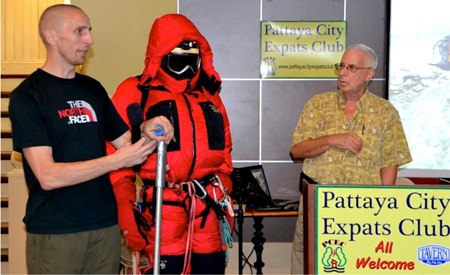 With the aid of a manikin, David demonstrates the clothing and gear necessary to climb Everest, including the ice pick. MC Richard Silverberg looks on.
With the aid of a manikin, David demonstrates the clothing and gear necessary to climb Everest, including the ice pick. MC Richard Silverberg looks on.
After David’s presentation Master of Ceremonies Richard Silverberg brought everyone up to date on upcoming events, then called on Roy Albiston to conduct the interesting and informative open forum where questioned are asked and answered about Expat living in Thailand. For more about the Pattaya City Expat Club and their many activities, visit www.pattayacityexpatsclub.com.



